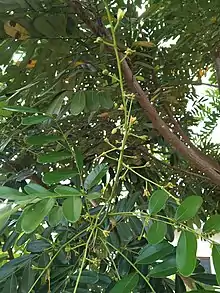| Simarouba glauca | |
|---|---|
 | |
| Scientific classification | |
| Kingdom: | Plantae |
| Clade: | Tracheophytes |
| Clade: | Angiosperms |
| Clade: | Eudicots |
| Clade: | Rosids |
| Order: | Sapindales |
| Family: | Simaroubaceae |
| Genus: | Simarouba |
| Species: | S. glauca |
| Binomial name | |
| Simarouba glauca | |
Simarouba glauca is a flowering tree that is native to Florida, South America, and the Caribbean. Common names include paradise-tree, dysentery-bark, and bitterwood. The tree is well suited for warm, humid, tropical regions. Its cultivation depends on rainfall distribution, water holding capacity of the soil, and sub-soil moisture. It is suited for temperature range of 10 to 40 °C (50 to 104 °F), and can grow at elevations from sea level to 1,000 m (3,300 ft). It grows 40 to 50 ft (12 to 15 m) tall and has a span of 25 to 30 ft (7.6 to 9.1 m). It bears yellow flowers and purple elongated oval fleshy fruits.
Cultivation
It can be propagated from seeds, grafting, and tissue culture technology. Fruits are collected in April and May, when they are ripe, and then dried in sun for about a week. Skin is separated, and seeds are grown in plastic bags to produce saplings. Saplings 2 to 3 months old can be transplanted to a plantation.


Use
The wood is generally insect resistant and is used in the preparation of quality furniture, toys, matches, and as pulp (in paper making). It also can be used for industrial purposes in the manufacture of biofuel, soaps, detergents, lubricants, varnishes, cosmetics, and pharmaceuticals.[3]
Claims of medicinal properties
Though there is some research[4] claiming that Simarouba is effective for treating certain diseases, there seems to be insufficient evidence[5] of curing diarrhea, malaria, edema, fever, and stomach upset. Known in India as Lakshmi Taru, the extracts from parts of the tree have been claimed to possess potent anticancer properties. However, to date, no systematic research using phytochemicals isolated from Simarouba glauca has been carried out to explore the molecular mechanisms leading to cancer cell death. Simarouba extracts are known to be effective only on specific types of human cancer cell lines and tests conducted were in vitro. Whether the same effect would be observed under in vivo conditions, depends on bioavailability and bioaccessibility; hence, Simarouba as an alternative cure for cancer remains unproven.
Environmental impact
The tree forms a well-developed root system and dense evergreen canopy that efficiently checks soil erosion, supports soil microbial life, and improves groundwater position. Besides converting solar energy into biochemical energy yearround, it checks overheating of the soil surface, particularly during summer. Large-scale planting in wastelands facilitates wasteland reclamation, converts the accumulated atmospheric carbon dioxide into oxygen, and contributes to the reduction of greenhouse effect or global warming.
See also
References
- ↑ Botanic Gardens Conservation International (BGCI).; IUCN SSC Global Tree Specialist Group (2019). "Simarouba glauca". IUCN Red List of Threatened Species. 2019: e.T150108258A150108260. doi:10.2305/IUCN.UK.2019-3.RLTS.T150108258A150108260.en. Retrieved 20 November 2021.
- ↑ "Simarouba glauca". Germplasm Resources Information Network. Agricultural Research Service, United States Department of Agriculture. Retrieved 2009-12-02.
- ↑ Lakshmi Taru tree answer to climate change problems: experts
- ↑ "Simarouba (Simarouba glauca) Database file in the Tropical Plant Database of herbal remedies".
- ↑ "SIMARUBA: Overview, Uses, Side Effects, Precautions, Interactions, Dosing and Reviews".
![]() Media related to Simarouba glauca at Wikimedia Commons
Media related to Simarouba glauca at Wikimedia Commons
